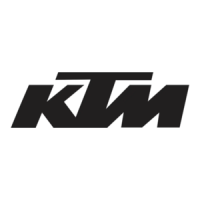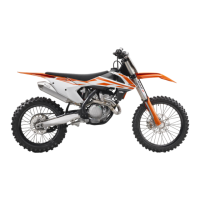Do you have a question about the KTM 380 SX and is the answer not in the manual?
Critical warnings about endangering body and life if instructions are ignored.
Cautions regarding damage to motorcycle parts or road safety if ignored.
Specific regulations for Australia regarding noise control systems.
Congratulates the owner and outlines the manual's purpose and content.
Location and identification of the motorcycle's chassis number.
Location and identification of engine number and type for 125/200 models.
Location and identification of engine number and type for 250/300/380 models.
Description and adjustment of the clutch lever's position.
Description and operation of the hand brake lever for the front wheel.
Explains the speedometer, odometer, and indicator lamps on the instrument cluster.
Explains the ignition lock and its various switch positions.
Details on short circuit, combination, headlamp, flasher, and emergency OFF switches.
Instructions for opening and closing the fuel filler cap correctly.
Guidelines for refueling, recommended fuel, and essential safety warnings.
Explanation of the fuel tap positions (OFF, ON, RES) and their functions.
How to use the choke knob for cold starts and operate the shift lever.
Operation of the kickstarter and adjustment of the foot brake pedal position.
How to adjust compression and rebound damping of the front fork.
How to adjust compression and rebound damping of the rear shock absorber.
Operation of the steering lock mechanism and the center stand.
Essential checks to perform on the motorcycle before starting each ride.
Advice for new riders on familiarization and safe initial operation.
Crucial safety and usage information specific to SX, MXC, and EXC models.
Recommended steps for breaking in the engine for optimal longevity.
Steps for starting the engine when cold, warm, or if it becomes flooded.
How to start moving, shift gears smoothly, and brake safely.
Instructions for safely stopping and parking the motorcycle.
How to adjust the clutch lever position for optimal ergonomics.
Steps for checking and adjusting the steering head bearing for safe handling.
Instructions for cleaning and maintaining the pivot bearing on suspension struts.
How to check the drive chain tension and its importance for safety.
Procedure for adjusting the drive chain tension correctly.
General advice for maintaining the drive chain for extended life.
How to check the drive chain for wear and when replacement is needed.
General information on brake calipers, pads, reservoirs, and fluid types.
How to adjust the free travel of the hand brake lever for responsiveness.
Procedure to check the front brake fluid level and identify potential issues.
Steps for refilling the front brake fluid reservoir with correct fluid.
How to inspect the front brake pads for wear and minimum thickness.
Guide for safely removing and installing the front brake pads.
Procedure to check the thickness of the rear brake pads.
Guide for safely removing and installing the rear brake pads.
How to adjust the basic position of the foot brake pedal.
Procedure to check the rear brake fluid level and identify potential issues.
Steps for refilling the rear brake fluid reservoir with correct fluid.
Step-by-step guide for removing and installing the front wheel.
Step-by-step guide for removing and installing the rear wheel.
Importance of tire pressure, checks, and recommended levels.
How to check spoke tension for wheel stability and safety.
Details about the fuse location, rating, and precautions.
Guidelines for battery care, storage, and charging procedures.
Procedure for replacing the H4 headlight bulb.
Explanation of the cooling system's components and function.
How to check the coolant level and associated safety precautions.
Steps for bleeding the cooling system to remove air bubbles.
Procedure for cleaning and oiling the air filter for optimal performance.
Information on checking and repacking the exhaust silencer with glass-fiber yarn.
How to clean the spark arrestor on EXC USA models.
Information on original settings for altitude, temperature, and fuel.
Guidelines for adjusting main jet, idle jet, and jet needle for performance.
Information on wear affecting carburetor components and performance.
Explanation of idling, part-throttle, and full-throttle adjustment ranges.
Procedure for checking the carburetor float level.
How to check the oil level in the hydraulic clutch master cylinder.
Step-by-step guide for bleeding the hydraulic clutch system.
How to check the transmission oil level for 125/200 models.
Procedure for changing the transmission oil for 125/200 models.
How to check the transmission oil level for 250/300/380 models.
Procedure for changing the transmission oil for 250/300/380 models.
Guidelines for cleaning the motorcycle effectively and safely.
Measures to protect the motorcycle from road salt and winter conditions.
Instructions for storing the motorcycle for extended periods.
Standard settings for front fork and rear shock absorber on 125/200 models.
Specified torque values for chassis fasteners and components.
Key tolerances and clearances for 125/200 model components.
Specifications for various gasket thicknesses used in 125/200 models.
Standard carburetor settings for 125/200 models as per Table 3.
Key tolerances and clearances for 250/300/380 model components.
Specifications for various gasket thicknesses used in 250/300/380 models.
General tightening torque specifications for various fasteners.
Standard carburetor settings for 250/300/380 models as per Table 4.
Standard settings for front fork and rear shock absorber on 250/300/380 models.
Specific torque values for chassis components on 250/300/380 models.
Critical warnings about endangering body and life if instructions are ignored.
Cautions regarding damage to motorcycle parts or road safety if ignored.
Specific regulations for Australia regarding noise control systems.
Congratulates the owner and outlines the manual's purpose and content.
Location and identification of the motorcycle's chassis number.
Location and identification of engine number and type for 125/200 models.
Location and identification of engine number and type for 250/300/380 models.
Description and adjustment of the clutch lever's position.
Description and operation of the hand brake lever for the front wheel.
Explains the speedometer, odometer, and indicator lamps on the instrument cluster.
Explains the ignition lock and its various switch positions.
Details on short circuit, combination, headlamp, flasher, and emergency OFF switches.
Instructions for opening and closing the fuel filler cap correctly.
Guidelines for refueling, recommended fuel, and essential safety warnings.
Explanation of the fuel tap positions (OFF, ON, RES) and their functions.
How to use the choke knob for cold starts and operate the shift lever.
Operation of the kickstarter and adjustment of the foot brake pedal position.
How to adjust compression and rebound damping of the front fork.
How to adjust compression and rebound damping of the rear shock absorber.
Operation of the steering lock mechanism and the center stand.
Essential checks to perform on the motorcycle before starting each ride.
Advice for new riders on familiarization and safe initial operation.
Crucial safety and usage information specific to SX, MXC, and EXC models.
Recommended steps for breaking in the engine for optimal longevity.
Steps for starting the engine when cold, warm, or if it becomes flooded.
How to start moving, shift gears smoothly, and brake safely.
Instructions for safely stopping and parking the motorcycle.
How to adjust the clutch lever position for optimal ergonomics.
Steps for checking and adjusting the steering head bearing for safe handling.
Instructions for cleaning and maintaining the pivot bearing on suspension struts.
How to check the drive chain tension and its importance for safety.
Procedure for adjusting the drive chain tension correctly.
General advice for maintaining the drive chain for extended life.
How to check the drive chain for wear and when replacement is needed.
General information on brake calipers, pads, reservoirs, and fluid types.
How to adjust the free travel of the hand brake lever for responsiveness.
Procedure to check the front brake fluid level and identify potential issues.
Steps for refilling the front brake fluid reservoir with correct fluid.
How to inspect the front brake pads for wear and minimum thickness.
Guide for safely removing and installing the front brake pads.
Procedure to check the thickness of the rear brake pads.
Guide for safely removing and installing the rear brake pads.
How to adjust the basic position of the foot brake pedal.
Procedure to check the rear brake fluid level and identify potential issues.
Steps for refilling the rear brake fluid reservoir with correct fluid.
Step-by-step guide for removing and installing the front wheel.
Step-by-step guide for removing and installing the rear wheel.
Importance of tire pressure, checks, and recommended levels.
How to check spoke tension for wheel stability and safety.
Details about the fuse location, rating, and precautions.
Guidelines for battery care, storage, and charging procedures.
Procedure for replacing the H4 headlight bulb.
Explanation of the cooling system's components and function.
How to check the coolant level and associated safety precautions.
Steps for bleeding the cooling system to remove air bubbles.
Procedure for cleaning and oiling the air filter for optimal performance.
Information on checking and repacking the exhaust silencer with glass-fiber yarn.
How to clean the spark arrestor on EXC USA models.
Information on original settings for altitude, temperature, and fuel.
Guidelines for adjusting main jet, idle jet, and jet needle for performance.
Information on wear affecting carburetor components and performance.
Explanation of idling, part-throttle, and full-throttle adjustment ranges.
Procedure for checking the carburetor float level.
How to check the oil level in the hydraulic clutch master cylinder.
Step-by-step guide for bleeding the hydraulic clutch system.
How to check the transmission oil level for 125/200 models.
Procedure for changing the transmission oil for 125/200 models.
How to check the transmission oil level for 250/300/380 models.
Procedure for changing the transmission oil for 250/300/380 models.
Guidelines for cleaning the motorcycle effectively and safely.
Measures to protect the motorcycle from road salt and winter conditions.
Instructions for storing the motorcycle for extended periods.
Standard settings for front fork and rear shock absorber on 125/200 models.
Specified torque values for chassis fasteners and components.
Key tolerances and clearances for 125/200 model components.
Specifications for various gasket thicknesses used in 125/200 models.
Standard carburetor settings for 125/200 models as per Table 3.
Key tolerances and clearances for 250/300/380 model components.
Specifications for various gasket thicknesses used in 250/300/380 models.
General tightening torque specifications for various fasteners.
Standard carburetor settings for 250/300/380 models as per Table 4.
Standard settings for front fork and rear shock absorber on 250/300/380 models.
Specific torque values for chassis components on 250/300/380 models.
| Transmission | 5-speed |
|---|---|
| Engine Type | 2-stroke single |
| Cooling System | Liquid Cooled |
| Front Suspension | WP USD |
| Rear Suspension | WP monoshock |
| Front Brake | Disc |
| Rear Brake | Disc |
| Fuel Capacity | 9.5 liters |












